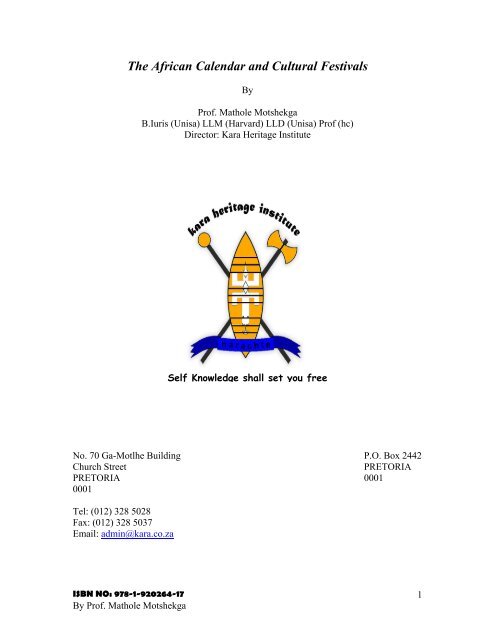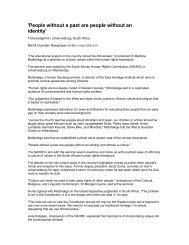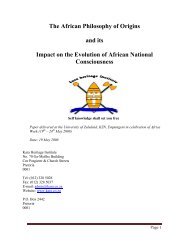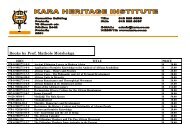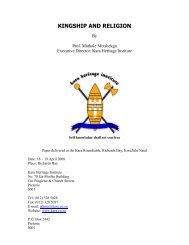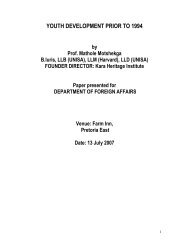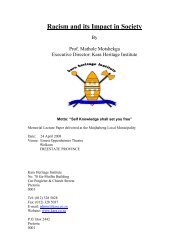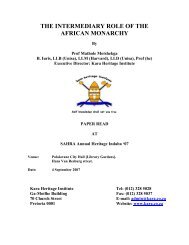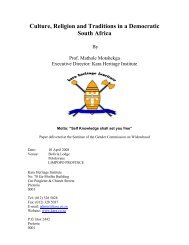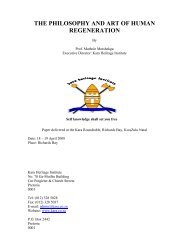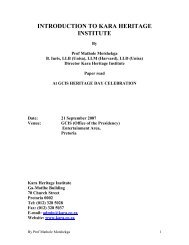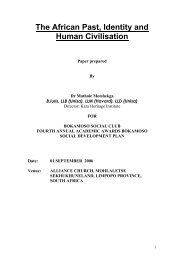The African Calendar and Cultural Festivals.pdf - Kara.co.za
The African Calendar and Cultural Festivals.pdf - Kara.co.za
The African Calendar and Cultural Festivals.pdf - Kara.co.za
You also want an ePaper? Increase the reach of your titles
YUMPU automatically turns print PDFs into web optimized ePapers that Google loves.
<strong>The</strong> <strong>African</strong> <strong>Calendar</strong> <strong>and</strong> <strong>Cultural</strong> <strong>Festivals</strong><br />
By<br />
Prof. Mathole Motshekga<br />
B.Iuris (Unisa) LLM (Harvard) LLD (Unisa) Prof (hc)<br />
Director: <strong>Kara</strong> Heritage Institute<br />
Self Knowledge shall set you free<br />
No. 70 Ga-Motlhe Building P.O. Box 2442<br />
Church Street<br />
PRETORIA<br />
PRETORIA 0001<br />
0001<br />
Tel: (012) 328 5028<br />
Fax: (012) 328 5037<br />
Email: admin@kara.<strong>co</strong>.<strong>za</strong><br />
ISBN NO: 978-1-920264-17<br />
By Prof. Mathole Motshekga<br />
1
<strong>The</strong> <strong>African</strong> <strong>Calendar</strong> <strong>and</strong> <strong>Cultural</strong> <strong>Festivals</strong><br />
1. Introduction<br />
2. <strong>The</strong> Philosophy of Origins<br />
3. <strong>The</strong> Spiritual Cosmology<br />
4. <strong>The</strong> Solar Cosmography<br />
4.1 <strong>The</strong> Great Year<br />
4.2 <strong>The</strong> Solar <strong>Calendar</strong><br />
4.3 <strong>The</strong> Lunar <strong>Calendar</strong><br />
5. <strong>Cultural</strong> <strong>Festivals</strong><br />
5.1 <strong>The</strong> <strong>African</strong> New Year<br />
5.2 First Fruits Festival<br />
5.3 <strong>The</strong> Harvest Festival<br />
5.4 Initiation <strong>Festivals</strong><br />
ISBN NO: 978-1-920264-17<br />
By Prof. Mathole Motshekga<br />
2
1. Introduction<br />
Every human family has a philosophy <strong>and</strong> history of its origins <strong>and</strong> art of being. <strong>The</strong><br />
<strong>Calendar</strong> of a people re<strong>co</strong>rds <strong>and</strong> articulates these essential elements of a people’s past,<br />
identity, culture <strong>and</strong> traditions. <strong>African</strong> people inscribed the essential elements of their<br />
intangible cultural heritage, indegeneous knowledge systems <strong>and</strong> calendar in Zodiacs, of<br />
Meroe, Dendera, Great Zimbabwe <strong>and</strong> Maphungubwe etc. <strong>The</strong>se Zodiacs <strong>co</strong>ntain a<br />
spiritual philosophy, <strong>and</strong> <strong>co</strong>smology on which the <strong>African</strong> <strong>Calendar</strong> is based.<br />
An underst<strong>and</strong>ing of the <strong>African</strong> <strong>Calendar</strong> requires knowledge of the <strong>African</strong> spiritual<br />
philosophy of origins <strong>and</strong> <strong>co</strong>smology which underlie <strong>African</strong> <strong>co</strong>smography. This<br />
monogram deals first <strong>and</strong> foremost, with these elements.<br />
2. <strong>The</strong> <strong>African</strong> Philosophy of Origins<br />
At the beginning there was nothingness or non-being. <strong>The</strong> First Cause begot itself out of<br />
this nothingness <strong>and</strong> came to be known as the self-begotten One or ultimate principle of<br />
being. This Being manifested itself as a triune principle made out of Mind (male),<br />
Thought (female), <strong>and</strong> Word (offspring of the two). This triune principle took the form<br />
of Absolute Light that existed before the birth of the universe(s). <strong>The</strong> principle of oneness<br />
or unity underlying all existence is, therefore, a triune principle of light known as the One<br />
or the Good.<br />
<strong>The</strong>re are ten principles which emanated from the One <strong>and</strong> took the form of a spiral, ten<br />
<strong>co</strong>ncentric circles or a python biting its tail. <strong>The</strong>se symbols represent the Universal<br />
virgin mother at the centre of the galaxy or in the region of the Milky Way.<br />
<strong>The</strong> Universal Virgin Mother gave birth to the spiritual father, mother <strong>and</strong> child<br />
symbolised by the three stars of the Orion belt. <strong>The</strong>se stars are three in One <strong>and</strong> One in<br />
Three <strong>and</strong> are also <strong>co</strong>nceived as the spiritual father. <strong>The</strong> stars Sirius A <strong>and</strong> B that<br />
emanated from the stars of the Orion belt represents the Cosmic mother <strong>and</strong> child. This<br />
Cosmic family is also symbolised by the Solar ( ) emblem. This emblem represents<br />
the Bull of Heaven <strong>and</strong> the four gods who guard the four quarters of the universe. <strong>The</strong><br />
Bull of Heaven <strong>and</strong> the <strong>co</strong>smic spirit that emanates from it are represented by a wheel of<br />
light which makes out the nerve centre of the universe. This wheel of light unfolded<br />
itself into the great <strong>and</strong> little universe.<br />
<strong>The</strong> Wheel of Light<br />
Fig. A<br />
ISBN NO: 978-1-920264-17<br />
By Prof. Mathole Motshekga<br />
Fig. B<br />
3
3. Spiritual Cosmology<br />
<strong>The</strong> Bull of Heaven or Wheel of Light unfolded itself into Seven Pleiades or Circumpolar<br />
stars which interacted in the form of two interpenetrating triangles sharing a centre. <strong>The</strong><br />
lower <strong>and</strong> Upper triangles represented fire (male) <strong>and</strong> water (female) respectively. <strong>The</strong><br />
interaction of the two triangles reproduced the macro<strong>co</strong>smic intelligence which<br />
transformed itself into the twelve houses of the macro<strong>co</strong>smic universe. <strong>The</strong> structure of<br />
this macro<strong>co</strong>smos is depicted by the following Bemben stone.<br />
3.1 <strong>The</strong> Macro<strong>co</strong>smos<br />
G<br />
8<br />
7 6<br />
5<br />
B<br />
E<br />
9 4<br />
A<br />
3<br />
10<br />
2<br />
11<br />
12<br />
1<br />
D<br />
H<br />
C<br />
F<br />
Fig A<br />
This macro<strong>co</strong>smos replicated itself in a micro<strong>co</strong>smos<br />
ISBN NO: 978-1-920264-17<br />
By Prof. Mathole Motshekga<br />
4
3.2 <strong>The</strong> Micro<strong>co</strong>smos<br />
5<br />
G<br />
6 7<br />
8<br />
B<br />
E<br />
4 9<br />
A<br />
10<br />
3<br />
11<br />
2<br />
1<br />
12<br />
D<br />
H<br />
C<br />
F<br />
Fig B<br />
4. <strong>The</strong> Solar Cosmology<br />
<strong>The</strong> two figures (A <strong>and</strong> B) make out the macro-micro<strong>co</strong>smic order <strong>co</strong>nsisting of the<br />
following hierarchy of Gods:<br />
• Bull of Heaven<br />
• Four Beasts of Heaven <strong>co</strong>rresponding to the four quarters of the Universe<br />
• <strong>The</strong> Seven <strong>co</strong>ws of Heaven represented by the seven Pleiades or circumpolar<br />
stars<br />
• <strong>The</strong> seven bulls of Heaven symbolised by the seven outer planets<br />
<strong>The</strong> seven Pleiades or circumpolar stars <strong>and</strong> seven bulls of heaven make out fourteen<br />
rungs of the ladder of heaven which link the Bull of Heaven (i.e. Father of Lights) <strong>and</strong><br />
humanity.<br />
<strong>The</strong> twelve houses of the macro<strong>co</strong>smos <strong>and</strong> twelve houses of the micro<strong>co</strong>smos<br />
<strong>co</strong>rrespond to the twelve hours of the day <strong>and</strong> twelve hours of the night.<br />
<strong>The</strong> aforegoing macro-micro<strong>co</strong>smic structure of the universe is the basis of the <strong>African</strong><br />
<strong>Calendar</strong> described below. <strong>The</strong>re are three <strong>African</strong> calendars, namely, the Great Year,<br />
the Solar <strong>and</strong> Lunar years. Each of these <strong>Calendar</strong>s is described below. <strong>The</strong> subdivisions<br />
of the twelve signs of the Zodiac are used for the <strong>co</strong>mputation of time.<br />
ISBN NO: 978-1-920264-17<br />
By Prof. Mathole Motshekga<br />
5
4.1 <strong>The</strong> Great Year<br />
Each of the twelve signs of the Zodiac is divided into 30 degrees, making the total<br />
number 360 (12 X 30) degrees. <strong>The</strong> Divine Light (<strong>Kara</strong>) that appear as the Sun (Ra)<br />
enters the eighth sphere of the universe (i.e. micro<strong>co</strong>smic zodiac) <strong>and</strong> traverses. <strong>The</strong><br />
duration that it took from the birth of time to the <strong>co</strong>mpletion of the first cycle is called the<br />
Great Year. Of <strong>co</strong>urse from the beginning of the world to date there have been many<br />
Great Years.<br />
<strong>The</strong> Sun (Ra), that is, ray of Light emanating from the Divine Light (<strong>Kara</strong>) entered the<br />
Zodiacal sign of cancer <strong>and</strong> traversed all twelve signs over a period of 25920 years called<br />
the Great Year. This period is calculated as follows.<br />
It takes the sun 72 years to traverse one degree <strong>and</strong> 2160 (30 X 72) to traverse one house<br />
of the zodiac. It, therefore, takes 25920 (2160 X 12) years to traverse all twelve signs of<br />
the Zodiac. Since the beginning of time the sun has <strong>co</strong>mpleted millions of great years.<br />
Thus the Orthodox creation date of 4004 BC is inaccurate. This is given as the year in<br />
which Adam was created. But long before this year the ancient Empires of Khem or Ta<br />
Shema, ancient Ethiopia <strong>and</strong> Egypt had long been founded <strong>and</strong> their civilisations was<br />
already advanced. Thus the <strong>African</strong> pre-dates the Adamic lineage. More specifically,<br />
<strong>African</strong> descended from Ptah (the master architect of the universe), not from Adam <strong>and</strong><br />
Eve.<br />
4.2 <strong>The</strong> Solar Year<br />
<strong>The</strong> sun enters the celestial sphere through the gate of cancer (Khepera or Haramanuba)<br />
<strong>and</strong> returns through the gate of Capri<strong>co</strong>rn (Anuba). <strong>The</strong> sun <strong>and</strong> the moon are born out of<br />
the internetion of the God of North ( ) <strong>and</strong> the God of the South ( ) who<br />
interpenetrate each other at the equator.<br />
<strong>The</strong> Interpenetration of the Gods<br />
Ntu<br />
Ra<br />
Ma<br />
Ra<br />
ISBN NO: 978-1-920264-17<br />
By Prof. Mathole Motshekga<br />
6
<strong>The</strong> union (Ntura) of the God of the North (Ntu) <strong>and</strong> God of the South (Ra) reproduces<br />
the union (Mara) of the female (ma) <strong>and</strong> male (Ra) principles at the equator.<br />
Thus the Area of the Great Lakes around the equator came to be known as the L<strong>and</strong> (Ta)<br />
of the Gods (Ntura or Mara). In one word the L<strong>and</strong> of the Gods is called Tantura or<br />
Tamara. This l<strong>and</strong> is also known as Punt or Afura i.e. the l<strong>and</strong> of the king, sun or God.<br />
<strong>The</strong> Solar year starts on the 23 rd September when the Sun appears below the body of the<br />
Zodiacal sign of Leo. This marks the begin of the <strong>African</strong> New Year. <strong>The</strong> <strong>African</strong> year<br />
is divided into three seasons of four months each. <strong>The</strong>se seasons are Summer (September<br />
to December), Autumn (January to April), <strong>and</strong> Winter (May to August). <strong>The</strong> <strong>African</strong><br />
year is also divided into four quarters, the two solstices <strong>and</strong> two equinoxes.<br />
4.3 <strong>The</strong> Lunar Year<br />
<strong>The</strong> moon has no original light. It derives its light from the Sun. This light traverses the<br />
fourteen stations of the moon <strong>co</strong>rresponding to the seven Pleiades or Circumpolar stars<br />
<strong>and</strong> seven outer planets. Thus for 14 days the Solar energy descends into the Sub-lunary<br />
world carrying the Solar Light to energize the world. For the remaining 14 days the<br />
moon ascends to the heavens to recharge through its reunion with the Sun. Thus the<br />
Lunar cycle takes 28 days. During the two dark days of the Moon the Moon (Ma) <strong>and</strong><br />
the Sun (Ra) are reunited, as female <strong>and</strong> male, to reproduce new Solar energy before a<br />
New Lunar Cycle. Thus <strong>African</strong>s revere the Sun <strong>and</strong> the moon individually or<br />
<strong>co</strong>llectively as Mara or Mari. <strong>The</strong> Primal shrine of the <strong>and</strong>rogyne God Mara is at<br />
Kumara or Tamara i.e. the source of the Nile at the foot of the mountains of the moon.<br />
<strong>The</strong> Lunar Cycle is made out of 30 (28+2) days. Each house of the Zodiac <strong>co</strong>nsists of<br />
three groups of ten stars called the decans. <strong>The</strong> moon takes 10 days to traverse each of<br />
the three groups of ten stars. Thus a Lunar <strong>co</strong>nsists of 3 weeks of 10 days each. <strong>The</strong><br />
moon spends 30 days in each of the 12 signs of the Zodiac, bringing the total number of<br />
Lunar year to 360.<br />
At the <strong>co</strong>mpletion of this annual lunar cycle the Union (Mara) of the Moon (Ma) <strong>and</strong> the<br />
Sun (Ra) reproduces the five elements of ether/spirit, water, fire, earth, <strong>and</strong> air. On each<br />
subsequent day, bringing the total number of a lunar year to 365. <strong>The</strong> union Mara of the<br />
Moon (Ma) <strong>and</strong> the Sun (Ra) is a reflection of the <strong>and</strong>rogyne planet Venus (Mara) mother<br />
of the planet Mercury (<strong>Kara</strong>). This planet Venus is also a reflection of the Queen of<br />
Heaven <strong>and</strong> Earth called Musasi or Mudjadji, popularly known as Mwalinkulunkulu or<br />
Muhale. Many peoples of Africa South of the Sahara worship this Goddess under<br />
different names. Hence, <strong>African</strong> <strong>co</strong>mmunities were largely matriarchal in nature.<br />
<strong>The</strong> patriarchal systems in Africa was introduced by the patriarchy in the Old Testament<br />
<strong>and</strong> the New Testament which disposed of the female God Sophia or Shekhina <strong>and</strong> only<br />
re<strong>co</strong>gnised Jehovah <strong>and</strong> Jesus who are both male. This patriarchy was made part of the<br />
secular law under <strong>co</strong>lonialism <strong>and</strong> Apartheid.<br />
ISBN NO: 978-1-920264-17<br />
By Prof. Mathole Motshekga<br />
7
In <strong>African</strong> Religion matriarchy is still alive. <strong>The</strong> Goddess Muhale or Mwalinkulunkulu<br />
who was worshipped by the Barozwi dynasty at Maphungubwe, Great Zimbabwe<br />
atMudzimungale at Lw<strong>and</strong>ali, now Tshiendeulu in the Zoutpansberg, is still worshipped<br />
at Masase, Mberengwa, Southern Zimbabwe, Makonde in the Vhembe district <strong>and</strong><br />
Maulwe, Balobedu district in Limpopo province.<br />
In ancient <strong>and</strong> medieval Africa the goddess Muhale was also known as Saba or Sapha<br />
(Greek Sophia i.e. Wisdom). This goddess is also known as kore or koremukuru.<br />
5. <strong>Cultural</strong> <strong>Festivals</strong><br />
<strong>The</strong>re are five cultural festivals which <strong>co</strong>rrespond with the seasons to the seasons of the<br />
year. <strong>The</strong> <strong>African</strong> Year is divided into four quarters of three months each <strong>and</strong> three<br />
seasons of four months each. <strong>The</strong>se <strong>African</strong> <strong>Cultural</strong> festivals are discussed below.<br />
5.1 <strong>The</strong> <strong>African</strong> New Year<br />
On the 23 rd August the sun appears between the paws of the celestial Lion (Tau or Simba)<br />
in <strong>co</strong>njunction with the star regulus (i.e. little king). A month thereafter, on the 23 rd<br />
September the sun appears below the body of celestial lion (Tau or Simba), marking the<br />
beginning of the <strong>African</strong> New Year.<br />
<strong>The</strong> <strong>African</strong> New Year is marked, in particular, by the appearance of the Bull of Heaven,<br />
also known as the Father of Lights (Ramasedi) <strong>and</strong> the four beasts of heaven which guard<br />
the four quarters of the universe. This five light beings are represented by the Solar ()<br />
emblem. <strong>The</strong> Father of Lights (Abakara or Ramasedi) is the physical manifestation of<br />
the Self-begotten God called Ptah, Mutangakugara or Umveliqani. Thus the <strong>African</strong> New<br />
Year is both a Spiritual <strong>and</strong> <strong>Cultural</strong> celebration.<br />
In October the Seven Pleiades or Circumpolar (Khelemela/Isilimela) stars appear to<br />
announce the ploughing times <strong>and</strong> the time of rain-ceremonies. <strong>The</strong> Bull of Heaven<br />
(Ny<strong>and</strong>ara) or Father of Lights (Abakara)/Ramasedi) <strong>and</strong> the Seven Cows of Heaven<br />
(represented by the Seven Pleiades or Circumpolar (Khelemela/Isilimela) stars manifest<br />
themselves as the wheel of Light of Solar wheel that moves the visible universe.<br />
or<br />
ISBN NO: 978-1-920264-17<br />
By Prof. Mathole Motshekga<br />
8
<strong>The</strong> appearance of the Bull <strong>and</strong> Seven Cows of Heaven (Ny<strong>and</strong>ara) or Father of Lights<br />
(Abakara)/Ramasedi) in the form of the Solar wheel in October every year marks the time<br />
for worshipping the Father of Lights <strong>and</strong> the seven stars which emanated from him. Thus<br />
<strong>African</strong>s <strong>co</strong>nceive the Godhead <strong>and</strong> its messengers (i.e. angels) as light, not human,<br />
beings. <strong>The</strong> Father of Lights (Abakara) is also known as Shambe, Nyambe or Sambe,<br />
Hamptah or Champtah (i.e. the Word of God Ptah).<br />
<strong>The</strong> <strong>African</strong> Worship of the Word (Ham or Zambe) of God Ptah is known as Memphite<br />
theology <strong>and</strong> it is re<strong>co</strong>rded in the Sabaka stone which was produced by the Ethiopian<br />
Pharaoh Sabaca who ruled the united empire of Ancient Ethiopia <strong>and</strong> Egypt.<br />
5.2 First Fruits Festival<br />
<strong>The</strong> seeds planted in October germinates <strong>and</strong> grow in November when Nature is reborn<br />
<strong>and</strong> both the plant <strong>and</strong> animal kingdoms increase. In December the First Fruits are ready<br />
for harvesting <strong>and</strong> <strong>co</strong>nsumption. <strong>The</strong>re are special rituals, governed by the phases of the<br />
moon which must be performed before the First Fruits are <strong>co</strong>nsumed. <strong>The</strong>se rituals are<br />
associated with the New <strong>and</strong> Full moon as well as the summer solstice (December 21-25)<br />
<strong>The</strong> summer solstice marks the birth of the five Gr<strong>and</strong> ancestors of humanity <strong>and</strong>, in<br />
particular, the Son of the Sun (Usara/Osiris). <strong>The</strong> First Fruits that are <strong>co</strong>nsumed during<br />
the time of the summer solstice symbolise the five Gr<strong>and</strong> Ancestors of humanity. <strong>The</strong>se<br />
ancestors are Usara (Osiris), Har-ar (Horus-ur), Sethe (Set), (M)usasi (Isis), Naphta<br />
(Nephtys). <strong>The</strong> first born children of these Gods are Hara (Horus), Son of (M)usasi <strong>and</strong><br />
Usara <strong>and</strong> Anuba, Son of Sethe <strong>and</strong> Naphta.<br />
<strong>African</strong> <strong>Festivals</strong> Days<br />
23 September: <strong>African</strong> New Year<br />
21 October: Rain-making ceremonies<br />
21-25 December: Birthdays of the Gr<strong>and</strong> Ancestors, symbolised by First<br />
Fruits festivals<br />
6 January: Sacrifice of a black bull to mark the beginning of the<br />
harvest season symbolised by the <strong>co</strong>ronation of Faro or<br />
Thobela – the harvest God.<br />
21 March – 20 April: During Easter when the Sun enters the Zodiacal sign of<br />
Aries special rituals are performed to thank God <strong>and</strong> Gods<br />
for the successful harvest.<br />
7 May: This day is called Mohale’s day <strong>and</strong> all work is prohibited.<br />
People brew beer, drink <strong>and</strong> celebrate this Goddess of<br />
Heaven <strong>and</strong> Earth known by diverse names.<br />
25 May: <strong>The</strong> Birthday of the Word or Son of the Goddess <strong>and</strong><br />
Beginning of Initiation Schools<br />
19 – 23 July: Birthday of the Child of Light (Hahul Ihy)<br />
15 – 23 August: Birthdays of the Gods (Neteru) of the First Time (Zep Tepi)<br />
ISBN NO: 978-1-920264-17<br />
By Prof. Mathole Motshekga<br />
9
5.3 <strong>The</strong> Harvest Festival<br />
In January (6 th ) a black bull is sacrifice to the Bull of Heaven (or Father of Lights <strong>and</strong><br />
Royal Ancestors who are intermediaries between the nation, god <strong>and</strong> gods. <strong>The</strong> sacrifice<br />
is made to ensure that Godhead enjoys the harvest before humanity. <strong>The</strong> actual time of<br />
the harvest takes place from the 21 st March when the Sun enters the zodiacal sign of<br />
Aries. In this period the Sun is called King or Monarch (Faro) who is sacrificed to<br />
nourish humanity.<br />
<strong>The</strong> King or Monarch (Faro or Fura) is also called Thobela or Ingwenyama, the 4<br />
messengers between the Gods <strong>and</strong> humanity.<br />
<strong>The</strong> sacrificial Lamb (Faro or Thobela) is reborn during the first full moon after Easter.<br />
<strong>The</strong> rebirth of this Monarch is followed by the rebirth of the Lunar Goddess (Maia),<br />
mother of Sambe or Nyambe (the Word or son) of the Goddess on May 7. This day<br />
marks the beginning of the Winter Season. In the Maphungubwe <strong>and</strong> Great Zimbabwe<br />
May 7 was celebrated as Muhale’s day. On this day all work was prohibited <strong>and</strong> people<br />
stayed at home <strong>and</strong> feasted.<br />
5.4 Initiation <strong>Festivals</strong><br />
On the 25 th May the star Canopus (Naka) appears before sunrise to announce the birth of<br />
the Word (Sambe/Nyambe) of the Goddess Maia or Muhale. <strong>The</strong> person who sees this<br />
star first reports to the royal <strong>co</strong>urt <strong>and</strong> is rewarded by a black <strong>co</strong>w symbolising the Queen<br />
of Heaven <strong>and</strong> Earth. <strong>The</strong> appearance of the Canopus star also announces the beginning<br />
of winter <strong>and</strong> initiated period.<br />
<strong>The</strong> initiation rituals prepare the youth for adult life which include: respect for authority,<br />
mutual respect for men <strong>and</strong> women, <strong>co</strong>mmunity service <strong>and</strong> reverence for god <strong>and</strong> gods.<br />
<strong>The</strong>se initiation rituals are followed by birth of the Gods in July <strong>and</strong> August.<br />
ISBN NO: 978-1-920264-17<br />
By Prof. Mathole Motshekga<br />
10


